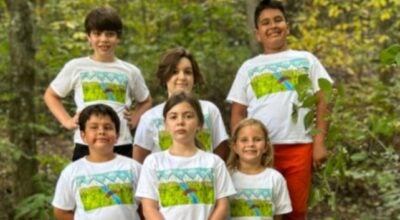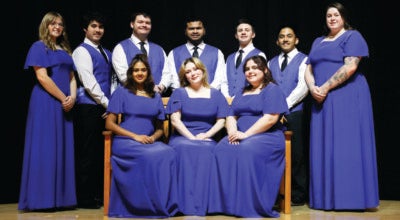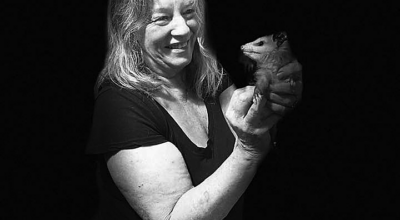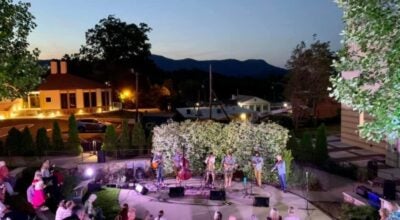Trash or treasure? It’s in the mind of the beholder
Published 10:47 am Tuesday, May 26, 2015
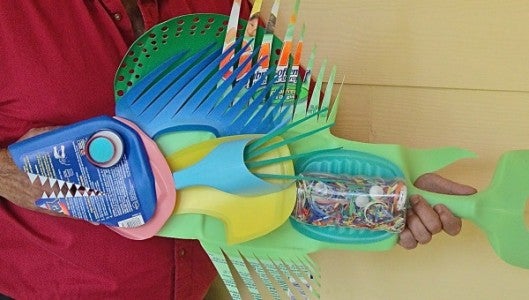
It’s a beautiful day in the mountains. I’m meeting with recycled plastic artist David Edgar, enjoying the view from his back porch while we talk. The first time I met David, I immediately noticed the colorful pin he was wearing. As he showed it to me I could see that it was fashioned out of different recyclable plastics—Clorox bottles and detergent bottles.
His Lake Lanier home displays many of his larger creations — tropical fish, a mobile of white birds created out of Clorox bottles, and a large dragon peering down on us from an elevated shelf. David has taken colorful, everyday throwaways and turned them into masterful creations.
Growing up in Gainesville, a third generation Floridian, he knew he wanted to be an artist by fourth or fifth grade.
“I wasn’t a jock,” David tells me. “And I wasn’t really academic, but I was creative. My art teachers encouraged me, and my parents were supportive. My Dad had originally dreamed of being a designer but life had taken him in a different direction, so he lived a bit vicariously through my creativity.”
“After prep school in Massachusetts, I attended Minnesota College of Art and Design, studying sculpture and printmaking,” he continues. “It was during this time period that I began to realize I might actually be able to earn money with my creative endeavors. Every year the college held a sale called the ‘Clothesline Art Sale’ giving students an opportunity to sell their work. I entered 22 pieces and sold all but one,” he smiles. “Even my mother commented that she now believed I could make money doing this.”
After further training and specializing in welding and metal sculpture, David was hired by Disney during the construction phase of Epcot Center and Japan Disneyworld by the Wed Imagineering department. I ask for some clarification as to what an imagineer is. David explained that an imagineer built what people imagined, sometimes out of materials like fiberglass.
After leaving Disney, David found his way into arts administration beginning in the late 1980s at the Armory Art Center in West Palm Beach. He was still welding sculptures while working. A chance encounter with an old acquaintance led him into the academic world at UNC Charlotte.
And this is where his imagination led to creating objects out of recycled plastics. David reminisces, “It was Super Bowl time and the Panthers were playing the Patriots. My wife, Robin, and I were invited to a Super Bowl party. The morning of the party we were out for our walk. I noticed plastic bottles in neighbors’ recycle bins with the bright colors of the Panthers team, a blue bottle, a black chicken tray, and a white Clorox bottle. My imagination took over and I salvaged some of these things. Once home, I cut them up and created a Panthers mask for the party. And this was the beginning of my recycling-sculpture career,” he laughs. “I began creating tropical fish based on my snorkeling and scuba days.”
An exhibit at the Fuller Craft Museum in Brockton, Mass. called Trash Formations validated his work and he began to take to take his recycled sculpturing seriously. When the American Craft Museum, a division of the Smithsonian, was looking for an artist to conduct a workshop that involved containers for their “Innovation Family Fun Festival,” David was invited to conduct the workshop.
“Stonyfield Yogurt donated containers and children used them to create butterflies and crabs,” he describes.
We discuss his craft as a new frontier in crafting. “Many people think of wood, cloth, metal, traditional materials, when they think of craft work. Plastics are new to this medium. I hold workshops at arts and craft centers including the John C. Campbell Folk Center in North Carolina, some museums, and schools. It keeps me busy. ”
The clouds are moving in and it’s time for me to leave. It’s been a fascinating story. Plastic, recyclable bottles will take on a whole new meaning as I toss them away. I’ll be checking the colors and thinking of David’s tropical fish and dragons. For more information on Edgar’s artwork, visit plastiquarium.com.


